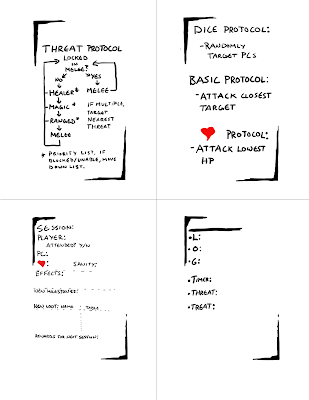"Hey... Why are all the monsters suddenly targeting me? This is so unfair!" - Some angry player, who was "arbitrarily" attacked 3+ times in a single turn of combat.
Sigh.
Arbitration. Fairness. Making that call. And perhaps worst of all, who does the dragon decide to snatch in its razor-sharp jaws? Welcome to Part 2 of the Jar of Evil, Monster Protocols or How to Train your Monsters.
Monster Protocol
There was a magnificent video by Runehammer on Monster Mind, essentially a thesis on creating A.I. for monster behavior. I loved it. A lot. I use nearly each one of those methods (someday I hope to use the Player Controlled monster), but I noticed something specifically lacking in those methods: how the monster directs those abilities.
Based on my observations of Runehammer, he tends to side more on targeting PCs with the dice than other methods. I can understand why, the dice are impartial. However, the dice have the same flaw in targeting PCs as they do in the Monster Mind itself:
It has the potential for extreme lethality.
It's also narratively confusing at times. Why would a monster chose this target over another purely because of a dice roll? I know there are plenty of other ways to target PCs for a GM's toolkit, but I wanted to integrate it into the Runehammer Monster Mind concept for when I feel the need for a truly fair or unique fight.
As a side-note, there is nothing new or ground-breaking in this post. Just my ramblings on the subject brought into one place.
Based on my observations of Runehammer, he tends to side more on targeting PCs with the dice than other methods. I can understand why, the dice are impartial. However, the dice have the same flaw in targeting PCs as they do in the Monster Mind itself:
It has the potential for extreme lethality.
It's also narratively confusing at times. Why would a monster chose this target over another purely because of a dice roll? I know there are plenty of other ways to target PCs for a GM's toolkit, but I wanted to integrate it into the Runehammer Monster Mind concept for when I feel the need for a truly fair or unique fight.
As a side-note, there is nothing new or ground-breaking in this post. Just my ramblings on the subject brought into one place.
BEHOLD! GM Grizzly's Monster Protocols:
Basic Protocol
The simplest targeting protocol of them all. The monster fights the closest target. If multiple targets qualify, either continue attacking the previous or randomly determine between the targets. If no targets are in range, move to attack the nearest target.
Heart Protocol
The monster seeks out the target with the lowest HP. How do they know this? The monsters with this protocol either have stellar instinct or an uncanny ability to smell weakness and approaching death.
Dice Protocol
A basic and fair targeting system. Use the dice, a D6 for example, to determine who gets the big bag of damage. Common, simple, and impartial. Many creatures use this, especially unpredictable foes.
Threat Protocol
Much like Runehammer's Monster Mind video was leading up to his Flow Chart A.I., the Threat Protocol is the summit of this post. It too is a flow chart of sorts, similar to the traditional method of going down the list of targets of the greatest threat to lowest, with a slight twist.
There is a logic gate. That logic gate is whether or not the monster is engaged in a melee it cannot easily disengage from. At that point, its Threat Protocol logic gate reverses until it gets to a point where it can resume the normal Threat Protocol. The reason is simple: priorities have now immediately changed from the battle at large to personal survival. It also builds into the monster the need for a Guardian or front-line Tank character: Force the BBEG to chomp on a "crunchier" character, and keep the Priest/Mage characters alive for another round.
This Protocol is the most complicated to keep control of in a mixed combat, so save it for an intelligent enemy and avoid having multiple monsters using it at a time.
CONCLUSION
I stated in the beginning nothing new would be invented here, and there wasn't. Truly. What is interesting (to me at least) is the idea of assigning these Monster Protocols to different monsters as part of their underlying Monster Mind, as opposed to deciding how you are going to target PCs that Round/Turn/Room. Grizzly Encounter MONSTERS actually proposes not only a Monster Mind for each monster, but a Monster Protocol as well, based on its characteristics and Jar. It also includes index cards with the Protocols for easy reference.
It's in their nature.

Comments
Post a Comment